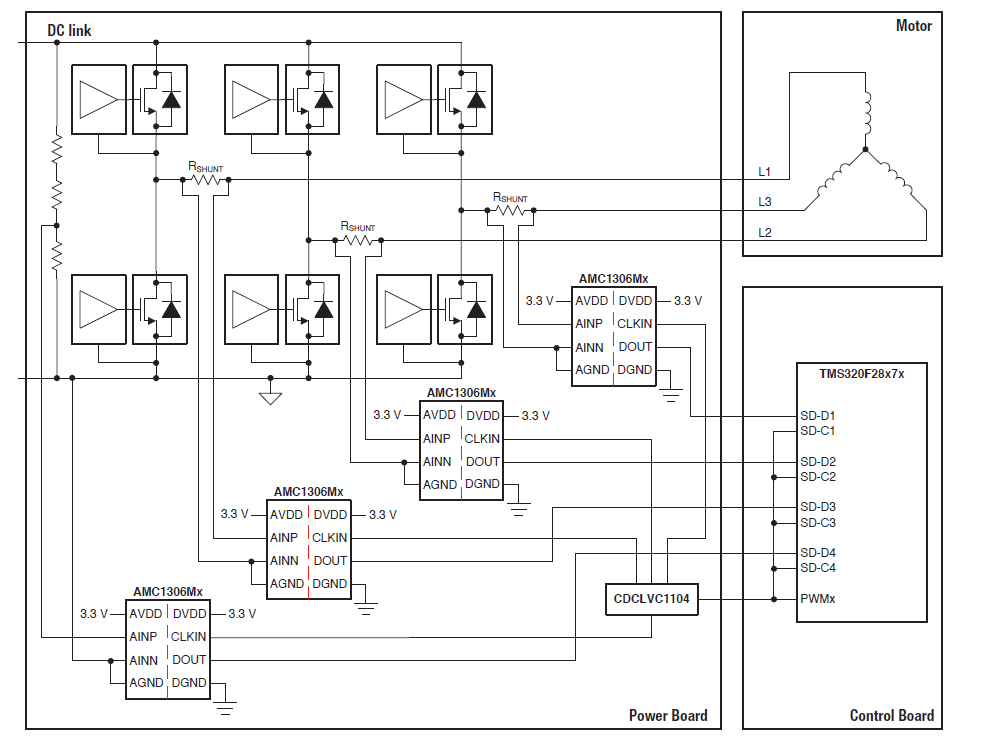SSZT946 september 2017
Industrial automation applications are incorporating more industrial robots and automated machinery. For example, robots can pick up an engine block, place it into a car chassis exactly, and return to their original position to perform another task with identical precision every time. But this would be impossible without precise motor-drive control.
Design Challenges for Precise Motor Control
To achieve precise and quick movements, a robot must react to torque changes while moving an object. For example, look at the current change that happens when operating a servo drive. Changes in motor load impact the current feedback that’s sensed, digitized and sent to a digital processing unit. High-speed digital signal processing algorithms in this digital processing unit determine in real time whether changing conditions make it necessary to adjust the power delivered to the inverter power stage. The processing unit sends a control output with pulse-width modulation (PWM) to the three-phase inverter in order to gate power switching and regulate the power outputs to the windings, thus supplying greater or lesser torque or speed from the motor. Additional sensing data fed into the controller can track input voltage and temperature changes. All of these components require a high level of performance for precise motor control.
Designing high-resolution current- and voltage-sensing feedback are two of the biggest challenges for motor-control systems. To avoid potential analog signal loss or interference, you probably increase the digitization of the feedback signals as close to the sensor as possible. But digital feedback signals can have potential problems with timing, especially as both increased clock speeds and rising sampling rates narrow timing windows further. Exacerbating the problem are different trace lengths for clocks and data signals.
TI’s Enabling Technologies for Motor-drive Control
The AMC1306 isolated delta-sigma modulator digitizes signals from current, then outputs a combined data and clock signal for maximum timing efficiency. Delta-sigma analog-to-digital conversion of the change in sensor output level is followed by Manchester coding of the clock rate onto the data stream, as shown in Figure 1, with the AMC1306 used for current, temperature and voltage sensing.
The result is a highly robust current- and voltage-sensing design that significantly decreases problems with setup and hold times associated with changes in operating temperature, thus simplifying three-phase motor-control system design and routing.
 Figure 1 Reinforced Isolated Phase
Current-sense Reference Design with Small Delta-sigma Modulators
Figure 1 Reinforced Isolated Phase
Current-sense Reference Design with Small Delta-sigma ModulatorsSimplified board routing enables you to build systems with small form factors but optimize performance, while addressing the needs of modern motor-drive systems.
TI has played a significant role in progressing high-resolution motor-control technology to help manufacturers push motor and motion control to higher levels. System developers know that they can turn to TI for a wide portfolio of integrated circuit (IC) solutions and in-depth support that helps advance the capabilities of their motor products.
Additional Resources:
- Explore TI’s wide motor-drive systems portfolio, with many options designed especially for lower voltages.
- Learn more about designing for high-efficiency power and motor-drive applications in this white paper.
- Click here to read how high precision in motor drive control enables industrial advances.